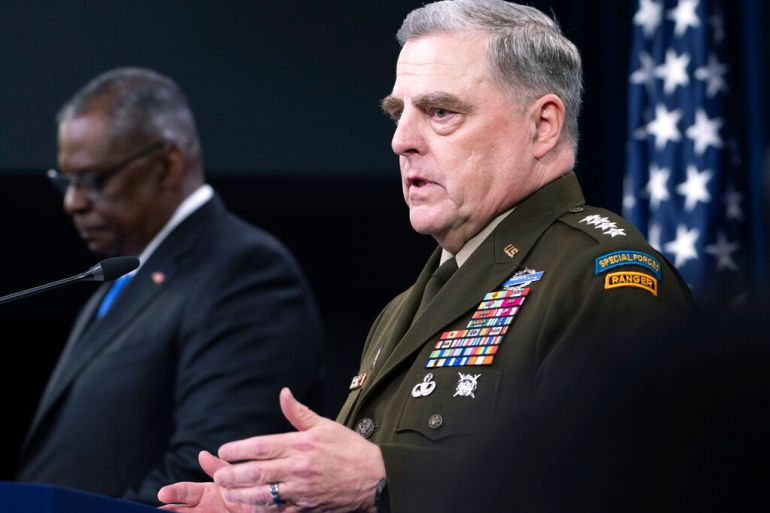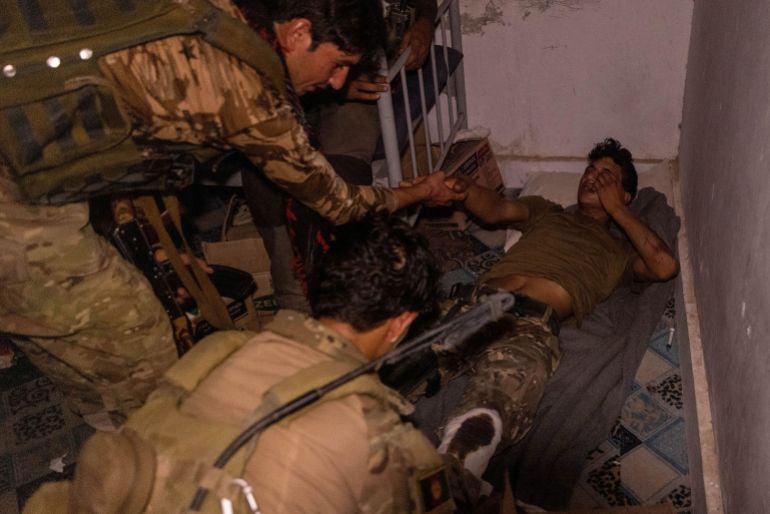Taliban seek to cut off Afghan population centres: Top US general
Taliban fighters have encircled 17 provincial capitals, outcome of Afghanistan peace talks uncertain, Mark Milley says.

Taliban fighters have gained “strategic momentum” in Afghanistan and now control about half the countryside as they drive to cut off population centres from the Western-backed government in Kabul, the United States’s top military general said.
“This is going to be a test now, of the will and leadership of the Afghan people, the Afghan security forces and the government of Afghanistan,” Joint Chiefs of Staff Chairman General Mark Milley told reporters at the Pentagon on Wednesday.
Keep reading
list of 4 itemsGeorge W Bush warns of ‘bad’ outcome of US Afghanistan pullout
Zalmay Khalilzad: How will US monitor Afghanistan after pullout?
‘Enemies of light’: Taliban destroying Afghan power, IT sector
The Taliban have gained control of about half of 419 districts in Afghanistan and are “putting pressure on the outskirts” of 17 of 34 provincial capitals but have not seized control of any of them yet, the top US general said.
“What they’re trying to do is isolate the major population centres. They’re trying to do the same thing to Kabul,” Milley said.
In response, Afghan government forces are “consolidating” their positions to protect population centres and the fighting is expected to escalate in the coming weeks following the Eid al-Adha holiday.
A delegation of Afghan government and Taliban representatives met in Doha during the weekend but failed to reach a hoped-for ceasefire agreement. Battlefield gains by the armed group have emboldened the Taliban which is advancing “a narrative” that they are winning, Milley said.
“They’re dominating the airwaves on that sort of thing,” he added.
President Joe Biden announced the US and NATO would withdraw forces no later than September 11, the 20th anniversary of the al-Qaeda attacks on the US that prompted the American invasion and occupation of Afghanistan. The US withdrawal has happened faster and is now expected to be completed by the end of August.
In exchange for the exit of foreign forces, the Taliban agreed to hold peace talks with the Western-backed government in Kabul aimed at achieving a political settlement that can lead to long-term stability for the war-torn country. And the Taliban agreed to prevent al-Qaeda or other armed groups from gaining a presence in Afghanistan.
“There’s a possibility of a negotiated outcome. That is still out there. There’s a possibility of a complete Taliban takeover. There’s a possibility of any number of other scents – breakdowns, warlordism,” Milley said.

Last week, the US provided three new propellor-driven A-29 Super Tacano light attack aeroplanes to the Afghan Air Force and three newly refurbished UH-60 Blackhawk helicopters.
“We are doing a lot to support the Afghan military and the Afghan leadership,” Milley said.
“They will continue to see a steady drumbeat of that kind of support going forward,” he said.
In addition, the US plans to help refurbish the Afghanistan Air Force’s fleet of Mi-17 Soviet-era helicopters, Pentagon officials have said.
The US withdrawal from Afghanstan is nearly 95 percent complete as of now, Milley said and is on track to be finished by the end of August.
The US has withdrawn 9,000 civilian and military personnel from Afghanistan and turned over control of all US military operating bases outside of Kabul to the Afghan Ministry of Defence, Milley said.
A contingent of about 650 US troops will remain to protect the US diplomatic presence in Kabul and its international airport. The US has asked Turkey to begin taking over responsibility for security at the airport.
At the same time, “we’ve stood up a node in Qatar that’s operational now” that will allow the US “to be able to conduct over-the-horizon strikes”, Milley said.
“Make no mistake that we remain committed to helping the Afghan security forces and the Afghan government going forward,” he said.